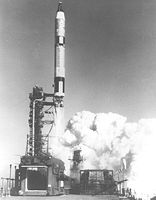Gemini 2
| Mission dates | |||||||
|---|---|---|---|---|---|---|---|
| Mission: | Gemini 2 | ||||||
| Launcher: | Titan II Gemini 62-12557 | ||||||
| Begin: | January 19, 1965, 14:03:59 UTC | ||||||
| Starting place: | LC-19 , Cape Canaveral | ||||||
| Landing: | January 19, 1965, 14:22:14 UTC | ||||||
| Landing place: | Atlantic | ||||||
| Flight duration: | 18min 16s | ||||||
| Earth orbits: | suborbital flight | ||||||
| Recovery ship: | USS Lake Champlain | ||||||
| Covered track: | 3422.4 km | ||||||
| Start photo | |||||||
 Start of the Gemini GT-2 mission |
|||||||
| ◄ Before / After ► | |||||||
|
|||||||
The Gemini-Titan Mission 2 (GT-2) was the unmanned launch of a Gemini spacecraft with the Titan rocket on January 19, 1965 at 9:04 a.m. EST from Cape Canaveral .
The primary objective of the mission was to test the Gemini spacecraft re-entry into the earth's atmosphere . A short ballistic flight was sufficient .
After April 1964, the results of the successful GT-1 templates mission that was NASA confident the first manned Gemini mission into in November of that year at the latest All to send. In between, the GT-2 mission's re-entry test was dated August 24th.
At the end of July the launcher was erected at launch site 19 in Cape Canaveral, assembled and connected to the external power grid .
In mid-August 1964, all further tests for the GT-2 mission were canceled. Eyewitnesses reported a possible violent lightning strike in or on the No. 19 launch tower. An extensive investigation was initiated, but no damage or evidence of a direct lightning strike could be found. Approval took place again at the beginning of September.
To the chagrin of NASA technicians, Hurricane Cleo hit Cape Canaveral at the end of August . When the forecast for the beginning of September also announced the hurricanes Dora and Ethel, the Gemini-Titan combination that had already been built was dismantled and could not be rebuilt until September 18.
The countdown for the start of the GT-2 mission was canceled on December 9, 1964, one second after the main engines had been ignited, as the automatic control unit detected the drop in hydraulic pressure in the control system of the first stage.
The mission was then carried out without errors on January 19, 1965. The ballistic flight brought Gemini 2 to an altitude of 171 km. 18 minutes and 16 seconds after take-off , the landing capsule watered in the South Atlantic 3419 km from the take-off point and was recovered by the aircraft carrier USS Lake Champlain . The heat shield test was now complete.
The Gemini-2 spacecraft was refurbished after its flight and provided with a hatch in the heat shield to serve as a prototype for the Gemini-B spacecraft, which was needed for the MOL project. In this configuration it was launched again on November 3, 1966 with a Titan IIIC rocket on a suborbital flight.
Web links
- Gemini 2 in the NSSDCA Master Catalog (English)
- Mission overview for Gemini-2 , NASA

